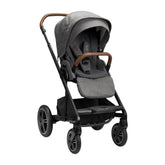Inducing Labor: 7 Natural Ways to Start the Process

Updated 19 Dec 2024
If you’re looking at your due date in the rearview mirror, the excitement of pregnancy has probably worn off at this point. By the end of your pregnancy, you’ll likely be anxious to have your baby safely delivered out of your belly and into your arms. While there are no guaranteed techniques that work to persuade your baby to make his or her grand arrival (other than induction by a doctor), there are a few natural ways to induce labor that may work for you.
Benefits of Waiting for Labor to Start Naturally
By around 40 weeks, many moms-to-be are feeling sore, uncomfortable, and tired of being pregnant. Nonetheless, there are several advantages to waiting for your body to begin labor spontaneously.
Women who are not artificially induced tend to recover more quickly than those who are, which means a shorter hospital stay for both you and your baby. In addition, infants who experience more time in utero typically have a decreased risk of low blood sugar, jaundice, and infection; improved feeding abilities; better respiratory function; increased muscle strength; and improved brain development. Allowing your baby to grow and develop for a few more days may be just what they need to arrive as healthy and strong as possible.
Safety Considerations When Trying to Induce Labor Naturally
If you’re still feeling anxious and want to try to induce labor naturally, there are a few considerations you should keep in mind. Doctors at the Cleveland Clinic warn that you should not attempt any natural induction methods unless you meet the following criteria:
- You have gotten approval from your healthcare provider.
- Your baby is head down.
- There are no current complications with your pregnancy that would cause these methods to be unsafe.
- You’re at least 37 weeks pregnant.
- There are no conditions that might make a vaginal delivery or unmonitored labor dangerous, such as a prior cesarean delivery or a placenta issue.
Once you’ve got the green light from your doctor or midwife, take a look at these suggestions on how to induce labor naturally.

The Quickest Ways to Induce Labor
1. Exercise
Get your heart rate going with a little exercise. Walking is especially helpful. Gravity and the movement of your hips may help pull your little one further down into the birth canal, and the added pressure may help ready your cervix for labor.
2. Nipple stimulation
The effectiveness of nipple stimulation does appear to have some sound scientific proof. Rolling or rubbing the nipples can aid the body in the release of oxytocin. This hormone is a key component of arousal, labor initiation, and attachment formation between the infant and birthing parent. It’s also the hormone that causes the uterus to tighten and the breast to expel milk. Nipple stimulation may also start full labor by inducing contractions that are longer and more powerful.
Research shows nipple stimulation may be a useful method to begin and encourage labor progress, avoid artificial induction, and minimize excessive bleeding after childbirth. Before you get started, understand that this method of labor stimulation can produce powerful results when used near your due date. It is only advised for low-risk pregnancies.
Soothing, cruelty-free Earth Mama Organics Nipple Butter is buttery and botanical-rich, lanolin-free, and non-sticky. It moisturizes dry skin and brings your nipples back to their happy place. And since it just might end up in the baby’s mouth, it’s Non-GMO Project Verified. So there’s no need to wash it off before nursing!

Earth Mama Organics Nipple Butter
3. Sex
Intercourse may be effective at inducing labor for several reasons. For one thing, sex (particularly sex involving orgasm) can stimulate the release of oxytocin, which may cause uterine contractions. For a pregnant person who has sex with a man, semen contains prostaglandins that can also help trigger uterine contractions.
Engaging in sexual intercourse is generally considered safe during the last few weeks of pregnancy, but you shouldn’t have sex after your water has broken, as you may be at increased risk for infection.
4. Acupuncture
Acupuncture is the traditional Chinese medicinal practice of sticking thin needles into areas of the body that are believed to control a specific organ or body part in an effort to relieve pain and prevent illness. According to research, the primary advantage of acupuncture is increased cervical ripening. Acupuncture should only be performed by a licensed acupuncturist.
5. Acupressure
Acupressure is an ancient healing practice that involves putting pressure on specific points on the body. Six major acupressure points on the body are believed to induce labor. It’s important to get proper instruction from a trained acupressure professional before attempting to apply these methods to your body. Even if acupressure doesn’t stimulate labor, for many mothers it’s a great way to reduce pain and lessen discomfort during childbirth.
Thinking of trying acupressure? Zoey Naturals Soothing Lavender Body Oil is smooth and soothing and provides hours of hydration to the skin. Zoey Naturals entire line of family products is free of harsh chemicals and gentle on the environment.

Zoey Naturals Soothing Lavender Body Oil
6. Eating Date Fruit
There is evidence that consuming dates late in pregnancy increases cervical dilation and cervical ripening at the beginning of labor and reduces the need for artificial induction and augmentation during labor.
7. Evening Primrose Oil
According to American Family Physician, evening primrose oil may help the cervix soften and thin out. Other research suggests that it can help reduce the length of labor. Evening primrose oil contains linolenic acid, which may stimulate a prostaglandin response in the body. That said, there aren’t enough formal studies on evening primrose oil to conclusively prove its effectiveness on labor or cervical ripening. Available research generally doesn’t show an especially powerful connection between the oil and triggering labor. For instance, one study found that women taking evening primrose oil labored an average of three hours longer than those who didn’t take the supplement.
Most of the favorable experiences of evening primrose oil are anecdotal. The supplement is often used alongside other natural methods of labor induction, making it difficult to separate evening primrose oil’s individual effectiveness.
The Bottom Line On Inducing Labor Naturally
Don’t attempt to induce labor without first consulting your doctor or midwife to review any potential risks or complications with your pregnancy. Remember, in most cases, it’s best to let nature take its course and let your baby arrive at their own pace, even if it means waiting a few more days.









